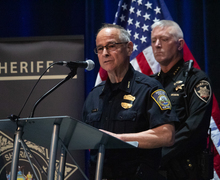National Science Foundation grant to benefit cyberinfrastructure at SU
Student computing and research at Syracuse University is about to get an upgrade thanks to a nearly $400,000 grant from the National Science Foundation.
The two-year, $396,068 grant will fund a cyberinfrastructure engineer position, allowing for more efficient use of advanced technologies on campus. For students and professors who need computers capable of handling big data, the grant is an “exciting development for SU,” said Chris Finkle, ITS communications manager.
The grant is a part of NSF’s Campus Cyberinfrastructure-Network Infrastructure and Engineering program, which invests in improvements and reengineering at the campus level to create network services that support scientific data transfers, Finkle said.
SU now has three NSF grants under its belt: a 2013 grant to improve its OrangeGrid network and another awarded in 2014 to improve its Academic Virtual Hosting Environments. OrangeGrid and AVHE are both meant to maximize a computer’s processing power for data-intensive research, such as by allowing researchers to run simulations and other research computer codes on idle computers, said M. Lisa Manning, an associate professor of physics, in an email.
The engineer, who has not been hired yet, would manage these systems and meet with students and professors to find out their computing needs, Manning said. The end goal is to improve student and faculty research opportunities.
“In particular, they would be able to help undergraduate and graduate students gain access to these resources, hosting seminars and learning workshops,” Manning said.
Eric Sedore, associate chief information officer for Infrastructure Services, said the position will strengthen both communication and collaboration among researchers on campus.
“This person will help close the gap between researchers and available computing resources both on campus and nationally,” Sedore said in an SU News release. “They will strengthen the collaborative nature of research computing work at the University and beyond.”
After the cyberinfrastructure engineer has been working for 18 months, a subcommittee of ITS officials and university professors will evaluate the position’s success and make a recommendation on how it will continue to be funded, according to the news release.
“This helps undergraduate and graduate researchers work on higher-impact projects that can make a real difference in the world,” said Manning, the associate professor of physics. “It also helps us attract federal funding for research to support undergraduate and graduate researchers, and improves the reputation of the University.”
Published on September 9, 2015 at 11:01 pm
Contact Mary: [email protected] | @mrycatalfamo




